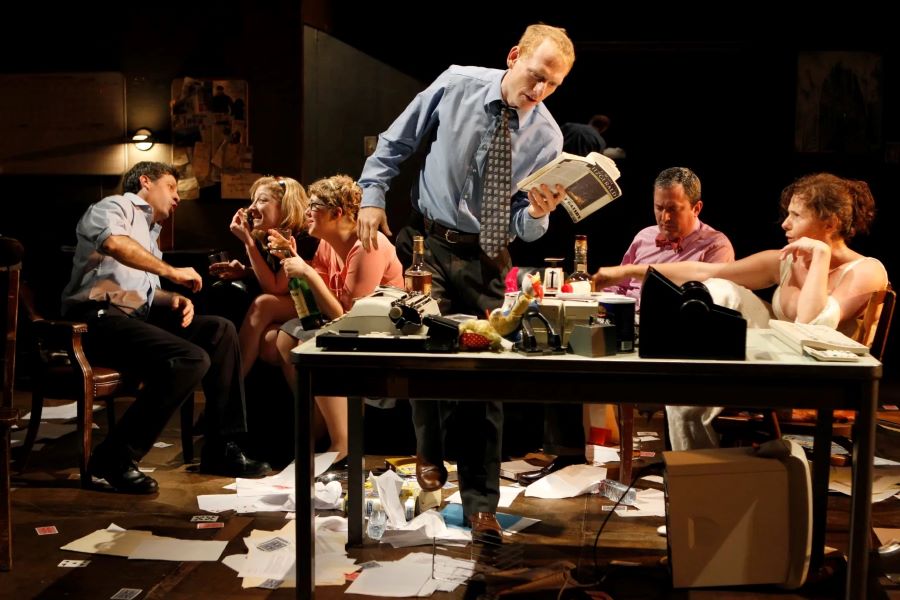En route to the Broadway opening of their Marilyn Monroe musical, lyricist Julia Houston (Debra Messing) drops another kind of bombshell on her longtime writing partner, composer Tom Levitt (Christian Borle): They’re getting the rights to adapt The Great Gatsby. Or so goes the plot in one episode of NBC’s short-lived television series Smash from 2013 (now headed for its own Broadway adaptation).
It was around that time that the wheels in my brain began to turn, imagining what a musical adaptation of F. Scott Fitzgerald’s classic 1925 novel might entail. Could the form capture the sociopolitical nuances of the novel, or would it give in to the temptation of Jazz Age window dressing? I only had to wait a decade to find out.
When the novel entered the public domain in the U.S. in 2021, a handful of new adaptation announcements followed. Most notably in the musical category: In true Wild Party double-header fashion, we learned that Florence Welch (Florence + The Machine), Thomas Bartlett, and Martyna Majok were developing their own interpretation of Gatsby, and so were Jason Howland, Nathan Tysen, and Kait Kerrigan.
These adaptations were hardly the first. Due to differences in copyright terms between the U.K. and U.S. (a period of 70 years there compared to 95 years here), The Great Gatsby had long been copyright-free in London by the time Joe Evans and Linnie Reedman staged a musical version there in 2012 and streamed it in concert in 2021.
The history of Gatsby onstage, though, predates its public domain status. Indeed, credit for the first Fitzgerald-sanctioned dramatic rendition must go to Pulitzer-winning playwright Owen Davis, who penned an adaptation that ran on Broadway for 112 performances in 1926, less than a year after the novel was published, then went on tour. As Davis observed in The New York Times, “It really would take a very clever man to make a bad play out of The Great Gatsby.”
Davis’s script was published earlier this year by Cambridge University Press. The introduction by editors James L.W. West III and Anne Margaret Daniel is worth reading, perhaps moreso than the play, which contorts characters, prose, and plot into a strange farcical melodrama that reads like an artifact from a parallel universe: Tom Buchanan is recast as a major in the Great War, Myrtle Wilson is a former chorus girl, Daisy’s family employs a maid in blackface, and Gatsby himself is an outright gangster. Davis’s play also served as the basis for a since-lost silent film, of which only the trailer footage remains. That’s probably for the best, considering F. Scott and Zelda Fitzgerald reportedly walked out of the cinema during a screening.
Despite its humble beginnings—it was not a commercial success during Fitzgerald’s lifetime, only really catching on when copies were distributed to American soldiers stationed overseas during WWII—The Great Gatsby has since solidified its place in the American literary canon and on high school reading lists. It has accordingly inspired an abundance of media: books, essays, graphic novels, video games, operas, ballets, radio broadcasts, and more. Film adaptations not lost to the annals of history include the 1949 version starring Alan Ladd, replete with transatlantic accents; the 1974 version with Robert Redford, Mia Farrow, and Sam Waterston, which takes great pains to highlight just how sweaty everyone would be in the summer heat on Long Island without air conditioning; the made-for-TV version from 2000, with Paul Rudd as Nick Carraway, which has the sentimentality and substance of a Hallmark movie; and, in all its extravagance, the Baz Luhrmann adaptation from 2013 starring Leonardo DiCaprio.
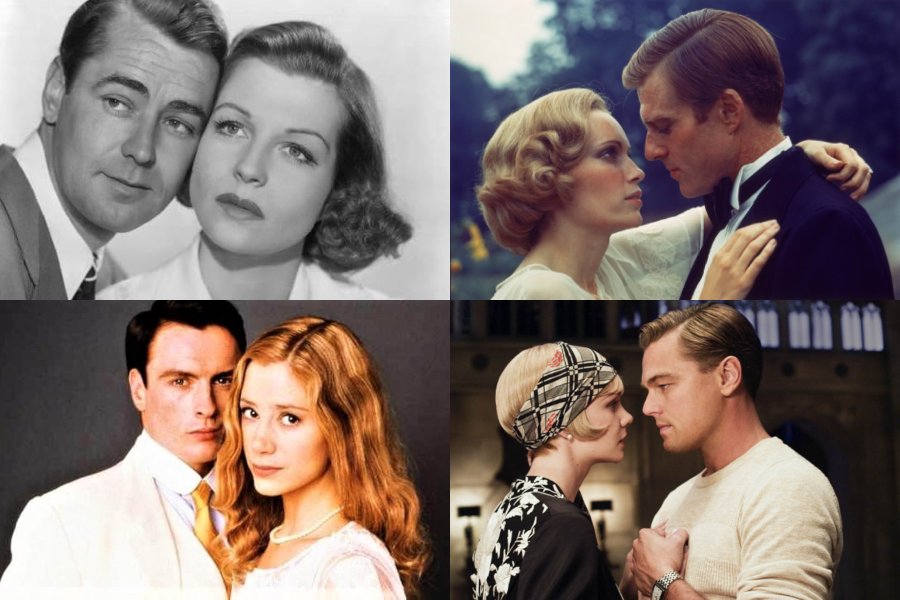
On a second watch, I think Leo’s casting works particularly well here—at certain angles, I can almost recognize the playful loverboy from Titanic, though I’m not sure that’s intentional. And who can forget that gorgeous soundtrack, including Lana Del Rey’s “Young and Beautiful” and Florence + the Machine’s “Over the Love”?
As a brand, Gatsby has proven profitable too. You’ll find the moniker affixed to restaurants, bars, hotels, a web developer, a chocolatier, and a wide swath of merchandise. The name has come to represent luxury and indulgence, due to the novel’s depiction of lavish Roaring Twenties parties. Buried under this facade of opulence, have these recurrent brand extensions already robbed Gatsby of everything but his heart and his teeth? It appears he keeps returning to bestow the same cursed blessings: hope and nostalgia.
Maureen Corrigan, Fresh Air critic and author of So We Read On: How ‘The Great Gatsby’ Came to Be and Why It Endures, told The Times last year that those who romanticize and mythologize Gatsby tend to focus “on one side of this incredibly nuanced novel, which is saying, ‘It’s beautiful to try, it’s beautiful to reach for the American dream’,” while disregarding the caveat that, “You’re going to fall short, you’re going to be disappointed, you’re going to be disillusioned.”
It was with this sentiment in mind that the New York theatre ensemble Elevator Repair Service created GATZ in the early 2000s, later staged to great acclaim at the Public Theater. (The six-hour show, a durational read-through/staging of the novel, returns to the Public for a run Nov. 1-Dec. 1.)
“What’s always disappointing to me,” lamented ERS artistic director John Collins, “is how easily seduced these adaptations are by the glamorous parties, the period costumes, the music. If you understand the novel, that is the most insignificant—its insignificance is very important. It’s the thing that is just so thin that it collapses…When an adaptation just goes whole hog, you end up becoming one of those party guests who’s seduced by the mythology of Jay Gatsby.”
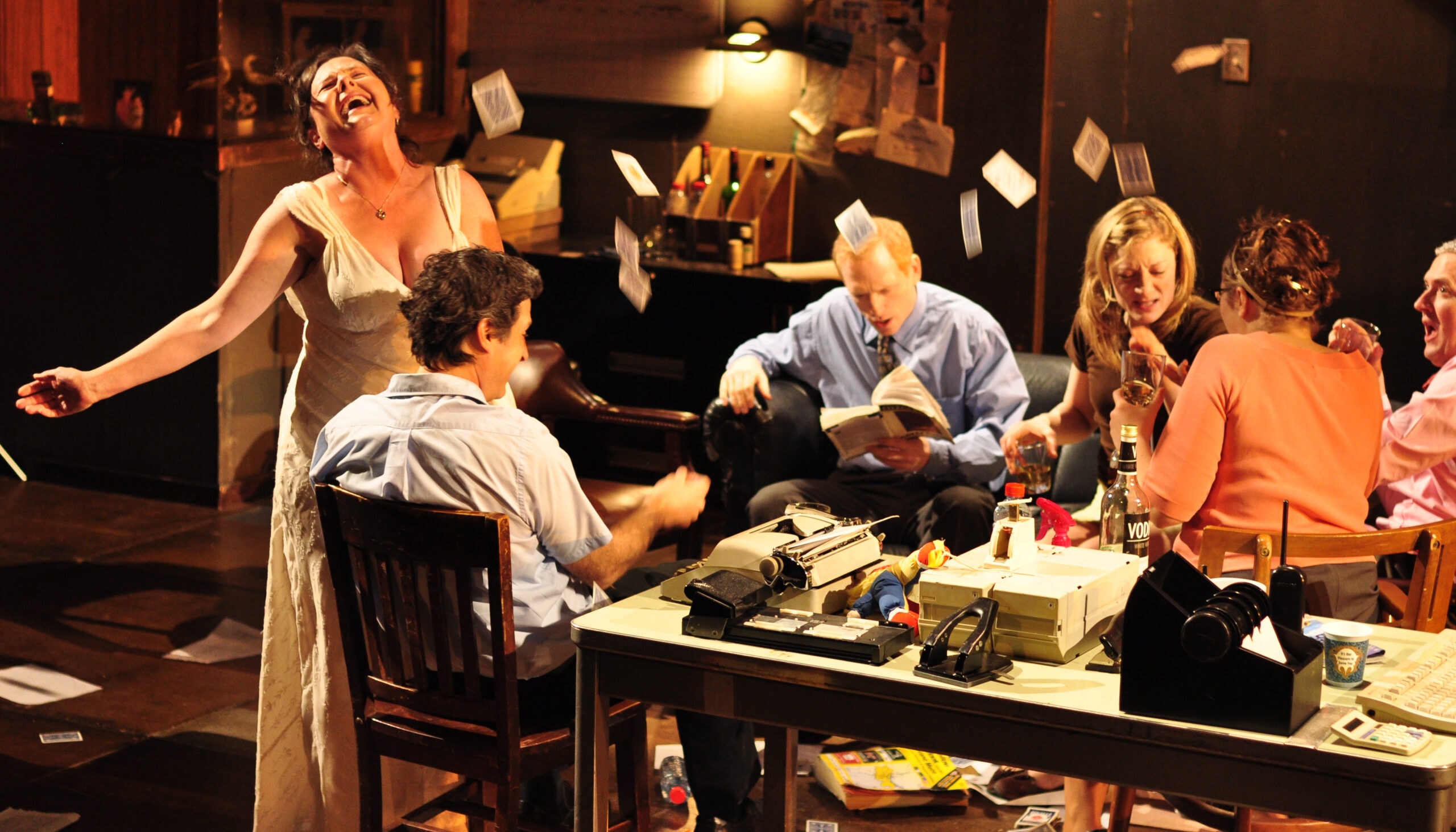
In a conversation earlier this month, Collins compared the novel to a crystal: one-of-a-kind, delicate, intricately constructed. “It’s an amazingly short novel that makes every word feel absolutely necessary,” he said. “That was what struck me about it early on; that was why we couldn’t edit it, because there was a perfect rhythm and music to every paragraph. It makes sense to do every single word of this, because it has achieved some kind of perfection even in its imperfections.”
Inspired by a stunt pulled by comedian Andy Kaufman, the ensemble landed on the revelatory idea of having actors (chiefly, Scott Shepherd) read the book aloud in its entirety—all 180 pages. Around him, an office of pen-pushers, numbed by their 9-to-5 grind, transform into literary likenesses, in much the same way that humble James Gatz became tragic hero Jay Gatsby. The eight-hour ritual encompasses six hours of performance broken up by a dinner break and two short intermissions. Critic Ben Brantley famously called GATZ “the most remarkable achievement in theatre, not only of this year but also of this decade.”
This staggering theatrical feat almost didn’t happen, due to years-long negotiations with the Fitzgerald estate. ERS’s rights request was denied in 2000 because A&E and BBC already had the rights to make their movie, and again in 2006, because Simon Levy’s drama was headed for the Guthrie Theater and presumed to be Broadway-bound. (Levy’s play, by the way, is lyrical, intuitive, apt, and fairly straightforward.)
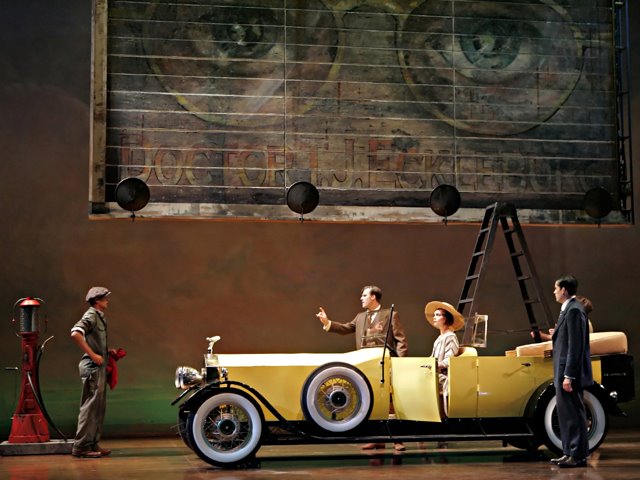
The phenomenon of GATZ gained traction thanks to clandestine, speakeasy-style rehearsals at the Performing Garage, to which only a select few were invited. The guest list fortunately included Oskar Eustis, who would go on to produce the show. GATZ gossip spread by word of mouth, until a cease-and-desist letter arrived from the Fitzgerald estate.
The compromise: GATZ could perform anywhere except New York or London. So the show premiered in Brussels at Kunstenfestivaldesarts in 2006, toured internationally with much success, then had its American premiere at the Walker Art Center in Minnesota before finally being cleared for a New York landing at the Public in 2010, and continuing to tour the country and the globe. The show’s upcoming Public run is billed as its final New York encore.
While he admitted to playing hooky for a chapter or two, Collins told me that in all these years he hasn’t missed a performance. “I have loved every minute of it, and I’ve come to appreciate so much about it,” he said of his unique experience listening to this novel thousands of times over, in the process “getting a kind of familiarity with it that you can only get that way.”
He recalled digging into the history of the writing: Fitzgerald’s letters, earlier drafts, the original manuscript at Princeton. “I’ve just loved getting into all of the minutiae and the details of how this thing came to be.”
I can relate. I’ve become a bit obsessed with Gatsby lore over the last year. I could dive head first into the archives, regale you with a heady analysis of symbolism and metaphor, and close with a brief but poignant soliloquy on the device of the unreliable narrator and the price of industrialization.
But I don’t have to. I already have my literature degree, and you’ve had just shy of 100 years to complete this oft-required reading assignment. April 2025 marks the centennial anniversary of the publication of The Great Gatsby. As this momentous occasion approaches, I’m more interested in discerning what these theatrical adaptations have to offer today’s audiences.
All About Atmosphere
When director Alexander Wright and producer Brian Hook devised an immersive production of The Great Gatsby in a struggling pub in York, England, back in 2015, they expected the show to be a one-off project with a limited four-week run. They couldn’t have predicted it would play in London for five years and tour Dublin, Brussels, Seoul, and New York.
“Everywhere we’ve done it, we’ve had to pretty much wholesale remake the show,” Wright told me recently over Zoom. Though the plot stays the same, every venue comes with its own challenges. “Each building we’ve gone into has had a different audience capacity, so it has had a different narrative capacity. Routes between rooms were different. The timing of everything was so complex to try and make the functionality of the show work and also still be all narrative-led, rather than feeling like you’re on some sort of technical carousel.”
Wright said the New York run of The Great Gatsby: The Immersive Show was the most ambitious, featuring three additional characters and a total of 10 interwoven storylines. I scored a ticket to the final performance at the Park Central Hotel in Manhattan in August 2023. For those who weren’t on the guest list, here’s what you missed.
Audience members, many of whom chose to dress for the occasion, were invited to attend one of Jay Gatsby’s infamous parties. Guests were ushered through the doors of an underground speakeasy and into the ballroom, an Art Deco jazz club where the majority of the action took place. George Wilson (Keivon Akbari) tended a cash bar, his wife Myrtle (Claire Saunders) waited tables, and as the giggle juice started flowing, other members of the company taught newcomers to dance the Charleston.
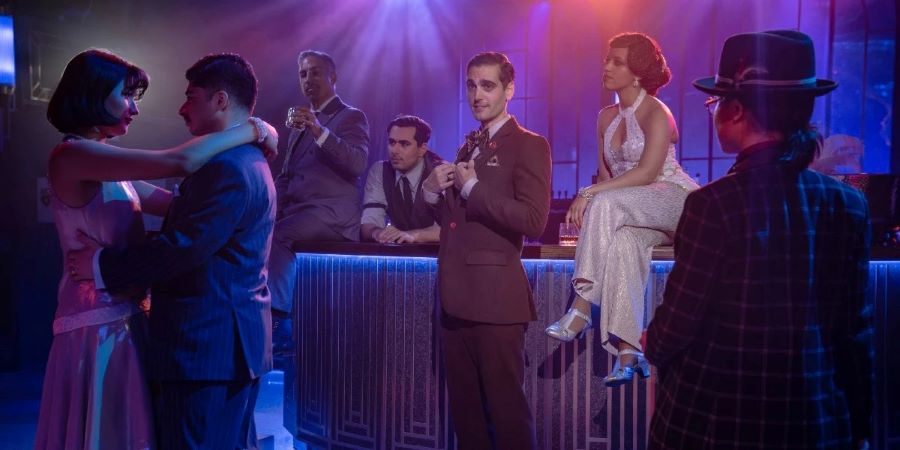
Amid the revelry, the cast took turns performing a mix of jazz standards and original compositions in that style by Glen Andrew Brown, Tendai Humphrey Sitima, and David Sims. It wasn’t quite a musical but a play with music. The choreography by Holly Beasley-Garrigan kept things light and fun, the costume design by Vanessa Leuck was dazzling, and taken together, the set design by Casey Jay Andrews, art direction by Shoko Kambara, and lighting design by Jeff Croiter was a sight to behold.
The plot thickened as each character’s secrets seeped into the ballroom. I was swept off on a side quest with Nick Carraway (Rob Brinkmann) to a Harlem pied-à-terre where Myrtle and Tom Buchanan (Shahzeb Hussain) were engaged in their tumultuous affair. You had to choose your own adventure wisely: Indeed, viewers would need to see the show 10 times to follow all the storylines.
We returned to the dance floor just in time to meet the mysterious Mr. Gatsby (Joél Acosta) and swooned at his reunion with Daisy Buchanan (Jillian Anne Abaya), the one that got away. At this moveable-feast Gatsby, our partygoer persona gave us bystander privileges. We were simultaneously “within and without,” as Nick would say.
“I find the relationship between audience, story, and space pretty thrilling,” Wright explained, adding that Gatsby provides fertile ground for immersion because of the novel’s proximity to social revolution. “It’s a really obvious invitation to integrate and infuse those ideas from the 1920s into a piece of social art.”
It also made us feel complicit when vehicular manslaughter and murder-suicide brought the festivities to a screeching halt. Talk about a buzzkill. That tends to be the problem with Gatsby adaptations: We’re either having too much fun or we’re miserable. When the lights came up, guests were invited to keep dancing, even after our host was toast. Just the sort of insouciance you might expect from East Egg elites who would gladly drink a man’s contraband liquor so long as they didn’t have to know where it came from. Still, the social critique was diluted by the booze.
The Party Never Stops
For their musical version, composer Jason Howland, lyricist Nathan Tysen, and book writer Kait Kerrigan accepted the challenge of adapting a great American novel for an international audience. It was producer Chunsoo Shin who first approached them with the idea of staging a musical production of The Great Gatsby in South Korea. At the time, there were no plans to bring their version to the U.S., but the trio were excited to work together toward the goal of a production.
And not just any production: “We were given carte blanche to write a big Broadway musical from the very beginning,” said Tysen recently over Zoom. He and Kerrigan, who are married, called in from their home in Maplewood, New Jersey. (Howland, meanwhile, was off working in Korea.) “That’s what our producer wanted, that’s what our director wanted—and that’s never been our experience writing a show. They wanted something big and lush and bold, and they wanted it to be a nod to old Broadway musicals.”
From the start, the goal was to make the novel more approachable for an unfamiliar audience. Said Kerrigan, “We were looking at it from the broadest possible angle, looking for the biggest-tent version of the story that we could find. What is the most universal feeling that both lives completely in the world of the show and also balloons out and connects you to a bigger feeling that anyone in the 21st or 20th century might have?”
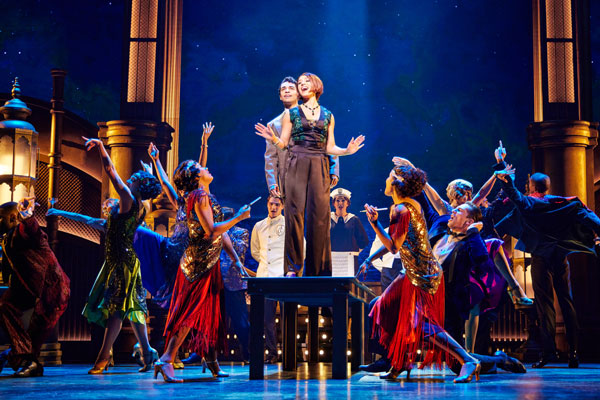
The Covid-19 pandemic and resulting lockdown delayed their plans to bring The Great Gatsby to Korea, so the creators and producers opted to develop the musical stateside. It premiered at Paper Mill Playhouse in fall 2023.
The creative team structured the musical as an escalating series of parties, culminating in catastrophe, which gave them the freedom to differentiate between the musical and the novel. Nick Carraway (Noah J. Ricketts) is largely relieved of his duties as narrator, drifting occasionally into comic relief territory.
There is something else to the role in this version. As a Black actor, Ricketts—alongside Samantha Pauly, who is Puerto Rican and Native American, as Jordan Baker—gives the show an opportunity to confront Tom Buchanan’s racism and xenophobia, as well as the novel’s dated portrayals of race and ethnicity, head on. But these nuances are only subtly referred to in the adaptation, so the musical’s focus naturally shifts toward the more active moments and dramatic players, namely Gatsby.
When I saw the production at Paper Mill, I was surprised and a little disappointed to see Jeremy Jordan’s Gatsby open the show. (Though he no longer sings the first line on Broadway, he is still the first character the audience sees.) I had initially assumed, when the subject line of the casting announcement appeared in my inbox, that the former Newsies star would be playing Nick Carraway. Jordan has no shortage of star power, to be sure, but he’s just so familiar, so charming, so safe. For the creators, this was intentional. They were advised by producers that Korean audiences would expect to spend as much stage time with the star as possible. Though this meant sacrificing some of Gatsby’s mystique, it ultimately fueled the storytelling.
“The thing about Gatsby is that he’s the person who has the most drive and the biggest want onstage,” Kerrigan noted. “So there’s a really reasonable argument to be made that he’s the guy who’s pulling all the strings and making it all happen.”
The impulse to balance the needs of the musical with the expectations of American audiences prompted several revisions ahead of the Broadway transfer. One big difference: The creators were still honing their sound. The original score felt too contemporary, they felt, so they settled on a more jazz-inspired pop score, with Big Band influences—though with a horn line that Tysen called “more Bruno Mars than Benny Goodman.”
“With all of the new songs that we wrote,” he said, “we definitely leaned much more into the ’20s vocabulary.” Gilda Gray’s scat salute “La Dee Dah With You” comes to mind.
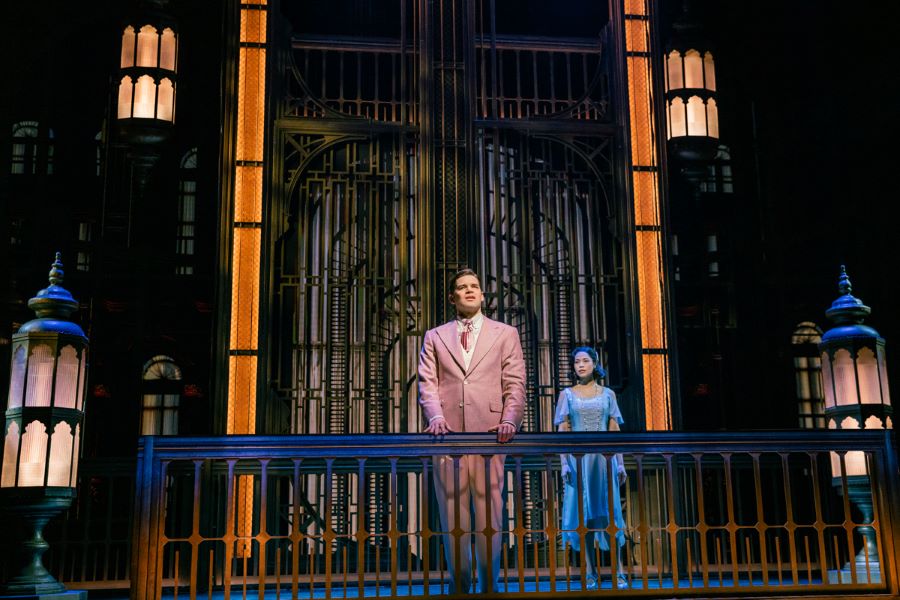
The musical I saw on Broadway in April is definitely an upgrade. The projections by Paul Tate dePoo III are still mesmerizing, but his sets are grander, the costumes by Linda Cho are flashier, the music is jazzier. The creators deepened the romance between Nick and Jordan, made Gatsby less Disney-esque, and amped up the fascinating rhythms. My one note: I wish they had focused slightly less on the lovers and given more time to the friendship between Nick and Gatsby. I found myself wondering whether Gatsby only befriends Nick to get close to Daisy, the object of his obsession. Is Gatsby an old sport or an opportunist? After the curtain fell, I overheard the tweens sitting a row in front of me gushing about how it was “so romantic.” I wanted to remind them that the man just died.
Two characters that thankfully haven’t changed are Paul Whitty’s George Wilson and Eva Noblezada’s Daisy. Whitty steals the show as the world-weary gas station attendant who gets entangled in a bootlegging scheme—if only his own bootstraps weren’t worn enough to snap. His desperate, grief-stricken shout into the void, “God Sees Everything,” gave me chills.
Likewise it’s hard to find a more layered performance of Daisy Buchanan than Noblezada’s. Betty Field’s performance in the 1949 film reminded me of Judy Garland in The Wizard of Oz, doe-eyed and impressionable; Mia Farrow’s Daisy appeared manic and flighty; Mira Sorvino’s was characteristically Southern belle; and Carey Mulligan’s was cold and distant. Noblezada brings her Filipina and Mexican heritage to the role, which adds to the suspicion that Daisy may be white-passing, as Tom suggests in the novel. Her portrayal is defiant, youthful, and at turns wise. Credit for this characterization goes to Kerrigan, who struggled to connect with the novel when she was assigned to read it in school.
“I thought Nick was beautifully rendered in the book, but the other characters didn’t feel as vivid for me,” Kerrigan said. She wasn’t alone. In her research, she learned that Fitzgerald himself fretted that he had not done Daisy justice and that some of the character’s dialogue had actually been spoken by his wife, Zelda. The Act II ballad “Beautiful Little Fool,” a reference to a line from earlier in the novel, brings the character, and the story’s sexism, into the spotlight.
Kerrigan said that her relationship with the novel has changed since writing the musical. “One of the coolest things has been watching high school teachers, who are predominantly female, come to see the show,” she said. “We had a huge group of them come in the summer. There were like 200 of them in the audience and we did a talkback. A bunch of them raised their hands, saying that this was the first time they felt connected to the material and that they got it.”
Another female character who gets a chance to shine is Myrtle Wilson, originated by Sara Chase, who returned to the role earlier this month after stepping away to undergo chemotherapy treatment. In this version, we discover that Myrtle is pregnant, presumably with Tom’s child, when she is fatally struck by Gatsby’s car. (This production features both a Coupe and a Rolls. Fancy!)
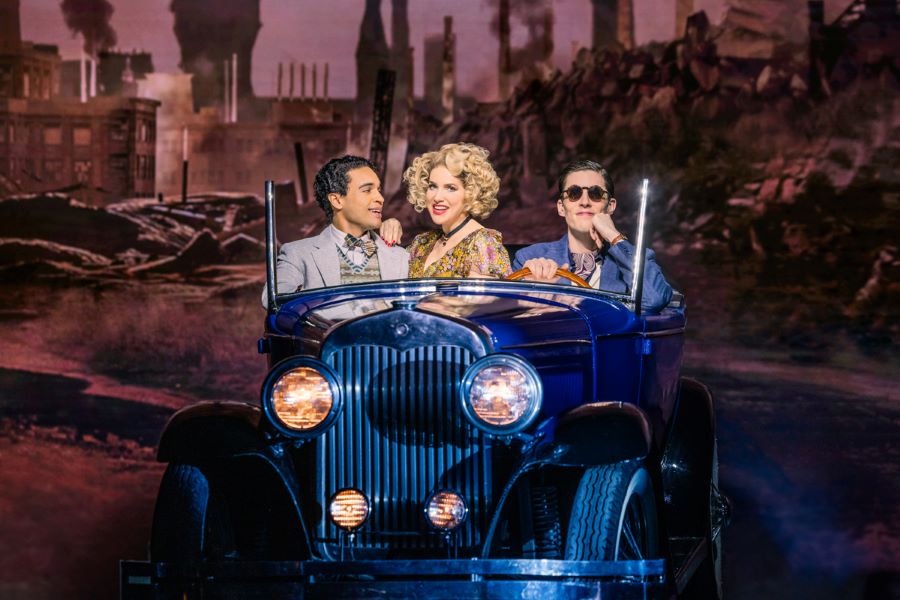
It isn’t the Gatsby we grew up with, but it might be the version we need. We are, after all, in the ’20s again, and history has a way of repeating itself. The novel depicts a country undergoing rapid industrial advancement, processing the aftermath of a major global conflict (World War I), and recovering from a pandemic (the 1918 flu). Sound familiar?
Kerrigan said that while she doesn’t think we’re destined to repeat the past, she sees the commonality between generations that have lived through such rapid, large-scale change. “It’s a whirlwind and it makes you an observer more than an actor in a lot of ways,” she said. “You aren’t a native of the technology that you’re experiencing, and so your relationship with it is always one of nostalgia, backward-looking and forward-looking at the same time.”
“I hope that we’re not repeating the past,” added Tysen. “But there is a large cross section of our country that wears big hats that say ‘Make America Great Again.’ There’s this desire to return to something.”
The concept of a glorious past, like the American Dream, is more of an illusion.
Faster, Farther, Deeper, Darker
In June, I completed the last leg of my Gatsby pilgrimage by train, Boston-bound to see the much-anticipated Gatsby: An American Myth at American Repertory Theater in Cambridge, Massachusetts. It was a remarkably singular experience. From the moment I arrived, I got the sense that they wanted the audience to disconnect from the present in order to appreciate the past. Cell phones were not merely silenced, but locked away in distraction-free Yondr pouches, as if they ceased to exist.
If the tone of the current Broadway production is brassy, ART’s was chrome-clad. Mimi Lien’s stunning set featured an avalanche of sculptural scrap metal, somehow billowing and crumpled around a cascading silver staircase. Designer Alan C. Edwards stretched the light outward and upward at the edges, catching the glint of cymbals in the high-perched orchestra pit.
Playwright Martyna Majok has spun a darker, grittier yarn by interrogating the novel’s themes of industrialization, class, and American identity. Florence Welch and Thomas Bartlett crafted an intoxicatingly bluesy folk-rock score, accented with tasteful touches of synth. The costumes by Sandy Powell evoked smoke and gasoline. Bodies bound by inky black fishnets and fringe twisted and entangled throughout Sonya Tayeh’s choreography. These parties oozed sex and scandal. Fingers sticky with tobacco and mouths smelling of booze found soft pleasures in dark corners.
Also: This Gatsby was queer as hell.
It’s the only production I’ve seen that tackles Nick Carraway’s sexual fluidity, revealed by his tryst with the photographer Mr. McKee, which comes not-so-straight from the source material. Abbott Elementary’s Ben Levi Ross was raw and vulnerable as Nick; I’m still shaken by the blend of rich baritone and sultry alto vocals he and others brought to numbers like “Pouring Down.” Someone please release the soundtrack, I beg.
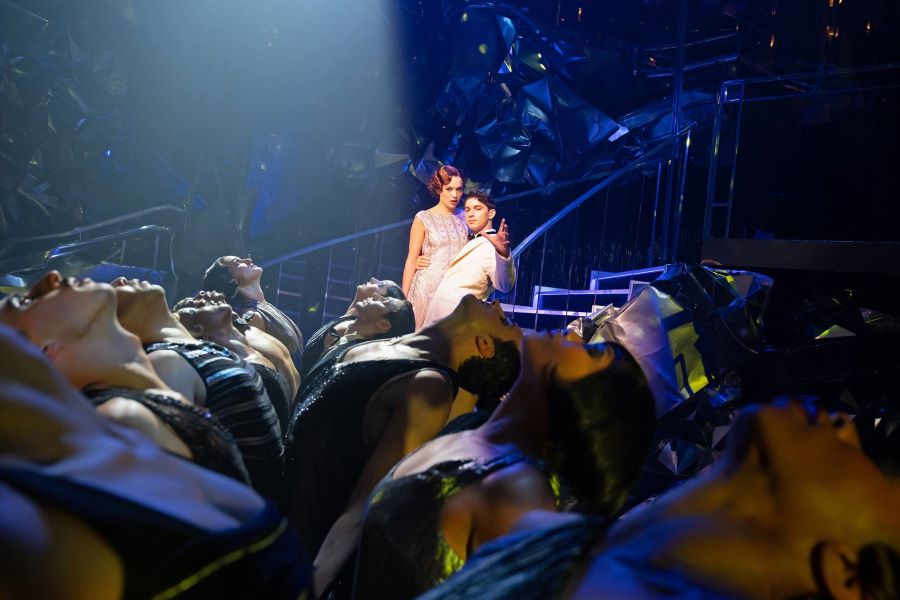
Charlotte MacInnes’s Daisy was a haunted Giselle, waifish and wounded, yet not without bite. Her “Golden Girl” glimmered against Isaac Powell’s strong and steady Gatsby. When she finally turned out the green light, we knew it was all over for them. As the characters’ corruption compounded, the hems of their garments got progressively stained with rust and debris. By the end, no one got away clean.
In this version, Myrtle (Solea Pfeiffer) grieved the loss of a child to the flu pandemic, and her husband (Matthew Amira), a war vet, was undeniably shell shocked. As in the immersive adaptation, Myrtle moonlighted at one of Gatsby’s parties, which kept her central to the action.
In a striking twist, the arrival of Gatsby’s father at his sparsely attended funeral revealed his Native American heritage. It’s the kind of detail that rocks you to your core and reframes the identity politics simmering under the novel’s surface.
Sadly, the show’s creators, who also included director Rachel Chavkin, were unavailable for an interview, and their press representative couldn’t confirm whether the production will have another life. Still, I expect we haven’t seen the last of this American myth.
Into the Past
The Atlantic has deemed millennials the new lost generation, and I am inclined to see the resemblance. It strikes me that, since the great misdirection of Columbus, Americans have always been a little lost. The only constant we’ve known is change.
Collins noted that any adaptation of Gatsby comes with an instant audience, and that ERS benefited from the novel’s legendary status. It’s not the only work of literature they’ve staged: They’ve also tackled Joyce, Hemingway, and Faulkner, albeit not verbatim.
But, he added, there will never be another GATZ, which the troupe first began devising around the time of the contested 2000 election. He’s conscious that the upcoming run of the show intersects with this year’s presidential election, and thinks the recurring resonance of the novel harkens back to a human obsession with shiny objects and “the sort of hopelessly aspirational way people think about wealth.”
Collins sees each of ERS’s works as distinct from the source material and worthy of their own title. “We got very lucky discovering Gatz, because James Gatz was really, or at least legally, his name,” Collins said. “That spoke to me, because it was a signal that we were looking under the surface with this, and that we were going to be dealing in something less glamorous, but more truthful.”
The truth is, there can be no greater Gatsby than the one we already have. And yet he always leaves us wanting more.
Alexandra Pierson is a former associate editor of American Theatre. She holds a dual bachelor’s degree from New York University in Journalism and English & American Literature, with a creative writing concentration in fiction. Alli was a 2024 National Critics Institute fellow.


